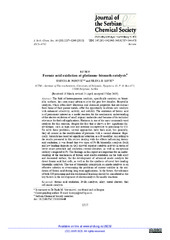| dc.description.abstract | The field of heterogeneous catalysis, specifically catalysis on bimetallic surfaces, has seen many advances over the past few decades. Bimetallic catalysts, which often show electronic and chemical properties that are distinct from those of their parent metals, offer the opportunity to obtain new catalysts with enhanced selectivity, activity, and stability. The oxidation of formic acid is of permanent interest as a model reaction for the mechanistic understanding of the electro-oxidation of small organic molecules and because of its technical relevance for fuel cell applications. Platinum is one of the most commonly used catalysts for this reaction, despite the fact that it shows a few significant disadvantages, such as high cost and extreme susceptibility to poisoning by CO. To solve these problems, several approaches have been used, but generally, they all consist in the modification of platinum with a second element. Especially, bismuth has received significant attention as a Pt modifier. According to the results presented in this review dealing with the effects influencing formic acid oxidation, it was found that two types of Pt-Bi bimetallic catalysts (bulk and low loading deposits on GC) showed superior catalytic activity in terms of lower onset potentials and oxidation current densities, as well as exceptional stability compared to Pt. The findings in this report are important for an understanding of the mechanism of formic acid electro-oxidation on the bulk alloy and decorated surface, for the development of advanced anode catalysts for direct formic acid fuel cells, as well as for the synthesis of novel low-loading bimetallic catalysts. The use of bimetallic compounds as anode catalysts is an effective solution to overcoming the problems of current stability in the oxidation of formic acid during long-term applications. In the future, the tolerance of both CO poisoning and electrochemical leaching should be considered as the key factors in the development of electrocatalysts for anodic reactions. | en |


